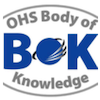Chapter 12.3.3: Document Usability
Abstract
While being low on the hierarchy of risk controls, procedures and other safety-related documentation are a vital element in occupational health and safety (OHS) hazard management and OHS management systems. Usability or UX engineering as applied to
safety-related documentation is a relatively new concept. However it is built on a significant science background that draws on psychology and neuroscience. This chapter identifies a need for a different approach to the development and design of safety-related
documentation. It introduces the science behind the usability of documentation. Emphasising that designing safety documentation for usability (UX engineering) is a skill and that the OHS Body of Knowledge cannot teach a skill, the chapter outlines how the science is applied to the design and content of procedures providing some illustrative examples. The chapter concludes with the implications for OHS practice.
Keywords: usability, UX, usability engineering, document, procedure, Usability Mapping, safety, OHS,
PQA
First year of publication: 2020
Current Version: 2020
Chapter 12.3.3: Document Usability
| 1 | Introduction |
| 2 | The need for a different approach |
| 3 | Historical perspective |
| 4 | Types of documentation |
| 5 | Science informing practice |
| 5.1 | Key document usability principles |
| 5.2 | General format |
| 5.3 | Content |
| 6 | Applying Usability to developing OHS documentation |
| 6.1 | Rationale for document |
| 6.2 | Document ‘specification’ |
| 6.3 | Document development |
| 6.4 | Document validation |
| 7 | Implications for OHS practice |
| 8 | Summary |
| 9 | References |
| Appendix 1 | Document usability audit checklist |
| Appendix 2 | Example UX procedure |

Klaus Hofer RN, BSc, MSc, PhD
Founder and CEO Cat-i
Klaus Hofer began his working life as a nurse working in Australia and Canada. Following a an incident involving a medical error his personal mission became to understand the science behind human behaviour that determined how people interpret and act on workplace documentation such as procedures. This mission led him to undergraduate studies in experimental and behavioural psychology and graduate studies in cognitive and neuropsychology. Working as a research associate for 13 years at the Nestlé Research Centre in Lausanne he applied existing cognition science to deduce lessons for document usability. These lessons were then tested throughout Nestlé’s production sites globally and subsequently developed into a course on applied psychology for technical communication. This work formed the foundation for the development of Usability Mapping®. In later years
Klaus has focused his work on the oil and gas industry as a high risk industry and where he has continued to refine the principles and application of Usability Mapping®.
The OHS Body of Knowledge takes a conceptual approach that enables it to be applied in different contexts and frameworks.
To optimise its value for education and professional development learning outcomes have been developed for each technical chapter in the Body of Knowledge.
The learning outcomes as described give an indication of what should be the capabilities of an OHS professional; it is up to those developing OHS education programs, OHS professionals planning their CPD or recruiters or employers selecting or developing people for the OHS function to consider the required breadth vs. depth.
Please read the section on using the learning outcomes before delving into the learning outcomes of the individual chapters.
The numbers against each learning outcome refer to the chapter number of the BOK download page. No learning outcomes have been developed for the chapters considered introductory or underpinning knowledge (that is chapters 1, 2, 3, 4, 5, 6, 7, 1, .13, 14, 15.)

